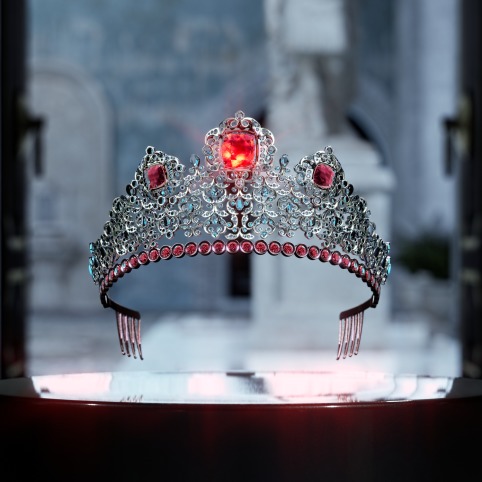When it comes to luxury fashion and the metaverse, the phrase ‘look how far we’ve come’ is practically made to measure.
For many business leaders, the metaverse and Web 3.0 present a new era of branding opportunities, as well as a largely untapped potential revenue stream.
“It’s the heart of where the internet is heading next […] and that’s why it’s really important to understand these concepts,” states CEO of Constellation Research, Ray Wang at the GDS Virtual Showcase in partnership with Microsoft.
But for others, the metaverse is shrugged off; all hype, and too whacky to grasp.
It is, after all, a virtual universe where users shop, play games, conduct business, and socialize with each other via their digital avatars.
It’s natural to expect luxury fashion leaders to congregate in the metaverse cynics’ camp. Their industry traditionally centres around finely crafted physical goods and they have a track record of scoffing at digital opportunities.
But, as the animal-fur trade can attest, attitudes in the luxury space can – and have – taken an about turn. Here’s how it happened.
We call this look: “Head-in-the-sand”
Back when Web 1.0 was introduced, luxury fashion executives made a horrible mistake: Put simply, they ignored it.
In 2008, Forrester and Walpole surveyed 178 premium and luxury brand executives, discovering that only 1 in 3 of them were selling online at all. Many luxury leaders snubbed online retail, deeming it a lowly substitute for the white-glove experience of a brick & mortar store visit. While the Forrester report generously called this a ‘missed opportunity’, it was in fact an outright refusal to acknowledge reality.
Amazon Prime was introduced in 2005, ecommerce giant Shopify launched in 2006, the Indian online marketplace Flipkart arrived in 2007, and by 2010, ecommerce accounted for 7% of all retail sales in the USA, up from 1% in 2000.
Digital shopping trends were irrefutably exploding, and still, luxury enthusiasts were forced to wait until 2015 for iconic French fashion house Chanel to announce its intent to launch an ecommerce store. “No, this is not an April Fool’s joke…” reported Harpers Bazaar magazine at the time.
Accepting the Inevitable
The exponential growth of luxury ecommerce marketplaces like Net-a-porter and Farfetch evidences an appetite amongst luxury consumers to make high-end purchases online.
“Farfetch was born out of boutiques’ need to reach their customers, and they needed to do it in a collective.” shared Kelly Kowal, Farfetch’s Chief Platform Officer at a GDS Retail Summit.
Thus, the past decade has seen high-end brands recognize (albeit at different paces) the necessity for a digital awakening.
Alexander Bolen, chief executive of Oscar de la Renta said in 2010 “if you had asked me two years ago, I would have said there is no way we are going to have any sort of evening clothes business online… I was totally wrong about that. I have been totally shocked at the sort of business we have done online.”
Furthermore, luxury players have found themselves collaborating with the very platforms who disrupted their industry to begin with. Kowal refers to the partnerships Farfetch has curated with the likes of Harrods and Tom Brown, and how they have benefitted from Farfetch’s innovations:
“We look at what retailers need today to be successful but we also to look at customer demands. Then we build the technology, so it is available for anyone in the market who wants to partner with us.”
-Kelly Kowal, Farfetch
From Ecommerce Reluctance to a Metaverse Fashion Revolution
Morgan Stanley’s prediction that the metaverse could curate a $56 billion luxury industry by 2030 – combined with the pandemic’s amplification of gaming and online shopping – has catalysed the most renowned fashion houses to proactively explore these spaces.
Not to mention, the metaverse has an exhilarating creative pull. An outfit that changes texture in accordance to the weather may not achievable in the physical realm, but London-based designer Scarlet Yang’s digital creations highlight that such constraints are irrelevant in the metaverse.
“I think about the metaverse as life extended; it’s life augmented; it’s life better” shares Liz Bacelar, Global director of Innovation at Estee Lauder, at the GDS CX Innovation summit.
As such, many of the most iconic luxury brands have been feeling-out the imaginative prospects that the metaverse has to offer:
French fashion house Balenciaga dove into the digital world in September of 2021, opening a virtual boutique alongside Epic Games – the developers who created the digital gaming universe, Fortnite. Fortnite users were able to purchase digital Balenciaga items, dress up their avatars, and connect with fellow luxury enthusiasts on the platform.
To mark its 200th anniversary, Louis Vuitton embraced the gaming concept further, by launching their own digital world, Louis the Game. Players could explore six imaginary worlds via the LV branded lens, with opportunities to acquire NFTs (non-fungible tokens) on their quest.
And speaking of NFTs, Italian designer Dolce and Gabbana auctioned off a collection combining real and digital pieces for around $5.7 million in September 2021. This included the “Impossible Tiara” NFT – a digital tiara, adorned with gems that do not exist on earth, wearable only by the proud owner’s digital avatar.

The Impossible Tiara
Source: UNXD
What can Metaverse Luxury Fashion teach us?
While the concept of buying a digital garment (that you can never wear in real life) may seem downright bizarre, there are tangible reasons luxury leaders are investing heavily in the space. These offer business leaders across all other industries some fundamental learnings:
- Meeting Customers Where They Are
According to Deloitte’s 2021 Digital Media Trends report, brands must participate in the metaverse if they wish to engage with Gen Z (people born between 1997 and 2012), since they make up 60% of all metaverse users (inlea).
And a new report from Klarna found Gen Z luxury purchases have significantly surpassed those of Gen X and Baby Boomer groups in the past 12 months. 60% of Gen Z, while only 46% of Gen X and 18% of Baby Boomers did the same.
Moreover, as their industry is characterized by pioneering trends and taste making, luxury leaders know they cannot simply meet Gen Z users in the metaverse, but they must innovate and disrupt the space to resemble the way in which their designs push boundaries in the real world.
- Empowering Emerging Tech Teams
In his recent keynote at the GDS Virtual Showcase in partnership with Microsoft, Ray Wang addressed business leaders who were waiting for the metaverse market to evolve, rather than innovating now:
“You want to get comfortable with these new sets of technologies [and] you want to have an emerging tech team that are spending time figuring out where [your brand] fits.”
He advises that exploring the space today is the key to getting your organization “metaverse ready” by the time the market has matured.
- Saying Hello to Huge Margins and Goodbye to Overstock
Digital assets do not need to be crafted from raw materials, nor do they require the labour to be physically made. Indeed, beyond their design, metaverse goods are almost pure profit.
What’s more, the metaverse presents a chance for brands to limit the current model of garment mass-production which often results in discount sales that decrease the label’s perceived value. Instead, brands can exhibit their collections on a metaverse catwalk, and correlate their production in the real world to the number of orders that have been made up front.
This merger of the digital and physical worlds could be instrumental in containing overproduction, curbing the fast-fashion industry model, and reducing wasteful manufacturing costs.
We call this look: “The Metaverse Mindset”
Leaders in customer experience, retail and luxury agree that the consumer buying journey has transformed, from a straight-line between home and the store, to a chaotic web that connects a myriad of on and offline touchpoints.
So it begs the question, as McKinsey’s State of Fashion 2022 report predicts hyper-interactive digital environments will only gather pace, how will your organization get metaverse ready?
GDS Summits are tailored 3-day virtual event conferences that bring together business leaders and solution providers to accelerate sales cycles, industry conversations and outcomes. Regarding the CX Innovation Summit 86% of Delegates said the overall experience of Digital Summit they attended was either Above Average or Excellent and 71% of Delegates said the Digital Summit provided them with actionable outcomes to support their current initiatives.
For more, click here to hear from attendees on how GDS has helped them to achieve their business outcomes.














